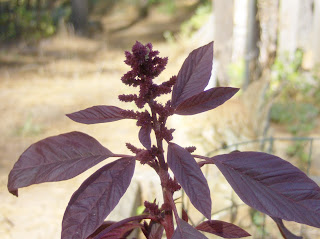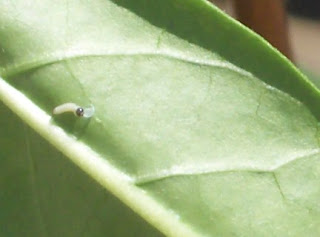Tomato Cage Christmas Trees
Don't put your tomato cages away yet!
That's right, it's still tomato cage season!!! With a little wire (I use 16 gauge galvanized craft wire),
some twist ties and/or plant wire,
tomato cages and plant stakes (for larger cages)
and mini-lights, it's real easy to turn those cages into outdoor Christmas trees for your yard.
Help usually isn't needed - it's pretty much a one person project, but if they come by and offer... well, good help is hard to come by...
Turn the cage upside down and slightly bend the 'legs' of the cage so that they make a nice, even cone shape from bottom to top (or top to bottom, since the cage is really upside down now---or is it?). Cut the wire where you can make 2 rings - one near the top of the 'legs', and one mid-way between that and the first welded ring on the cage. Attach them in place with twist ties.
When I'm using the taller cages (4½' or taller) I like to use a plant stake as a 'trunk' to help stabilize and form the top of the 'tree'.
Center the trunk/stake inside the cage by using the wire, tied off at a couple different rings towards the top of the tree.
For my large cages (5') I use 2 strands of 100 mini-lights. It's always helpful to test the lights before you start to tie them off to the cage ;) Replacing any burned out bulbs is always much easier in your lap or on a desktop.
Starting at the bottom, twist-tie off the first light at the base of the cage, and string it up to the top of the cone (in this case, a 6' plant stake inside a 5' cage). Tie the string off at the tip, and run the string back down to the bottom. Tie it of again about 1/3 the way around the bottom ring. Then move over another third on the bottom ring, tie it off again, and run the string back up to the top.
Take your 2nd string (again, test the lights first)
When you're stringing the lights, don't stretch the light string too tight against the cage...kind of let one light point left, and one point right, in a zig-zag sort of way. After doing this a couple times, you'll figure out just how much to stretch the wire while running it up and down the cage. Then, go back and twist-tie each string off at each loop. This will keep the lights from swaying too much in the wind and possibly breaking.
On the 4½ foot cages, I use just 1 100' strand of lights, attached to each leg. For the 42" cages, I also use just 1 100' string, but make 5 lines of lights up and down the cage, equally spaced around the bottom ring.
Once you're set up, it only takes about 15 minutes for each tree, other than a little tweaking to get the lights spread out right.
Up close, they might not look like much. Strategically placed around the yard, however, it adds a special magic to the nighttime Christmas landscape.
Now, go plant some tomato cage trees!!!
That's right, it's still tomato cage season!!! With a little wire (I use 16 gauge galvanized craft wire),
some twist ties and/or plant wire,
tomato cages and plant stakes (for larger cages)
and mini-lights, it's real easy to turn those cages into outdoor Christmas trees for your yard.
Help usually isn't needed - it's pretty much a one person project, but if they come by and offer... well, good help is hard to come by...
Turn the cage upside down and slightly bend the 'legs' of the cage so that they make a nice, even cone shape from bottom to top (or top to bottom, since the cage is really upside down now---or is it?). Cut the wire where you can make 2 rings - one near the top of the 'legs', and one mid-way between that and the first welded ring on the cage. Attach them in place with twist ties.
When I'm using the taller cages (4½' or taller) I like to use a plant stake as a 'trunk' to help stabilize and form the top of the 'tree'.
Center the trunk/stake inside the cage by using the wire, tied off at a couple different rings towards the top of the tree.
For my large cages (5') I use 2 strands of 100 mini-lights. It's always helpful to test the lights before you start to tie them off to the cage ;) Replacing any burned out bulbs is always much easier in your lap or on a desktop.
Starting at the bottom, twist-tie off the first light at the base of the cage, and string it up to the top of the cone (in this case, a 6' plant stake inside a 5' cage). Tie the string off at the tip, and run the string back down to the bottom. Tie it of again about 1/3 the way around the bottom ring. Then move over another third on the bottom ring, tie it off again, and run the string back up to the top.
Take your 2nd string (again, test the lights first)
and tie it off half way between where the first string of lights was attached. Back up to the top, tie it off, back down, tie it off between the first strings, move over again 1/3 of the way around, again between the first string, and run it back up to the top and tie off.
When you're stringing the lights, don't stretch the light string too tight against the cage...kind of let one light point left, and one point right, in a zig-zag sort of way. After doing this a couple times, you'll figure out just how much to stretch the wire while running it up and down the cage. Then, go back and twist-tie each string off at each loop. This will keep the lights from swaying too much in the wind and possibly breaking.
On the 4½ foot cages, I use just 1 100' strand of lights, attached to each leg. For the 42" cages, I also use just 1 100' string, but make 5 lines of lights up and down the cage, equally spaced around the bottom ring.
Once you're set up, it only takes about 15 minutes for each tree, other than a little tweaking to get the lights spread out right.
Up close, they might not look like much. Strategically placed around the yard, however, it adds a special magic to the nighttime Christmas landscape.
Now, go plant some tomato cage trees!!!

































































